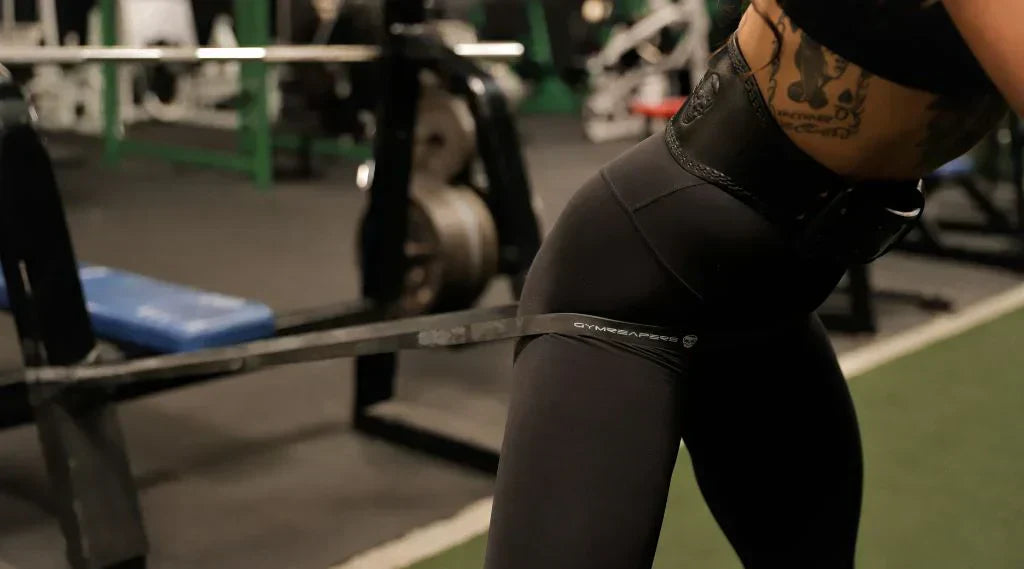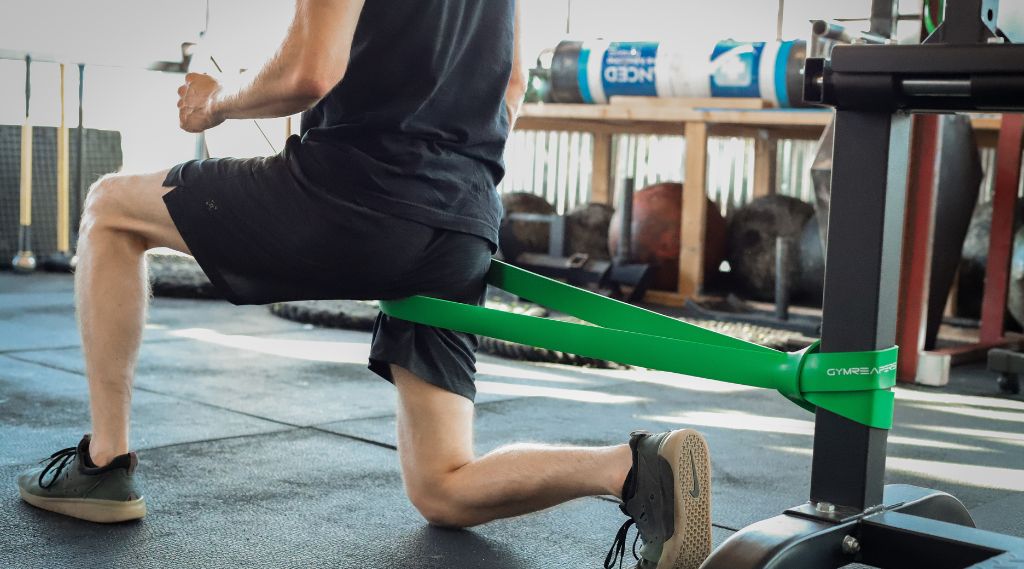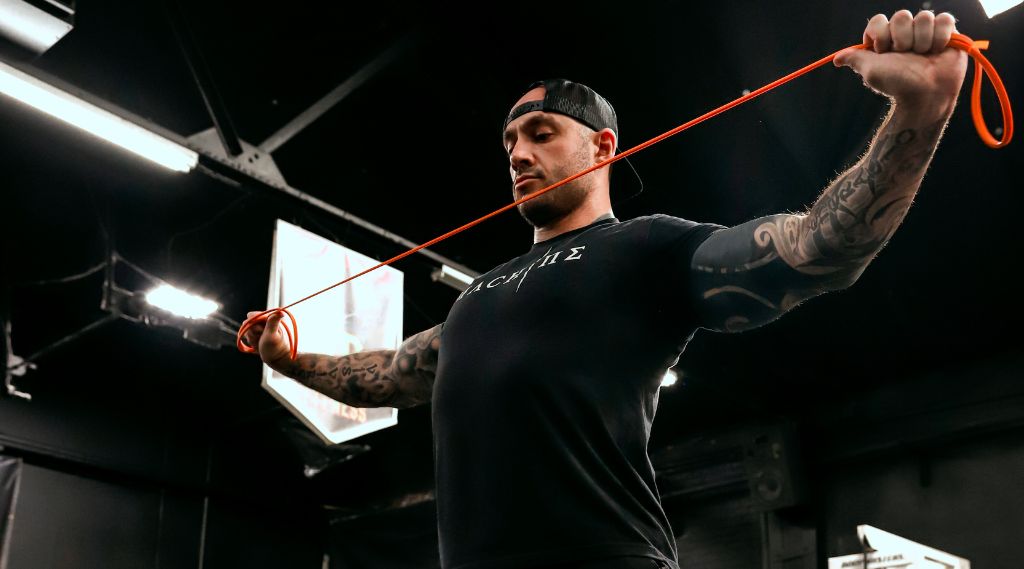As a personal trainer, I love prescribing resistance band exercises for an area that doesn’t get enough love: the hip flexors.
The hip flexors are a group of muscles with crucial roles in walking, running, jumping, weightlifting, and more. Resistance bands are the ideal tool because they improve muscle activation, create the necessary overload, and can be used for simple and effective hip flexor exercises, including seated knee tucks.
That said, you should know exactly which exercises to focus on and how to perform each to maximize your training efforts and reduce the risk of injury.
Key Takeaways
- The hip flexors are a group of five muscles whose primary function is to flex the hips, causing the knees to get closer to the chest.
- To keep your hip flexors functioning optimally it’s important to stretch and strengthen them because they are often tight and weak.
- Resistance bands provide more tension as they lengthen, which improves hip flexor activation by forcing stronger contractions to complete each repetition.
Anatomy of the Hip Flexor Muscles
The hip flexor group consists of five muscles: the psoas, iliacus, pectineus, sartorius, and rectus femoris (one of the four quad heads). As their name suggests, these muscles flex the hips, bringing one or both knees closer to the chest.
Tight or weak hip flexors can contribute to lower back, knee, or hip pain. Strength training should target these muscles along with the hamstrings and glutes to maintain balance and stability.
These muscles have an agonist-antagonist relationship with the hip extensors: the hamstrings and glutes. In other words, the hip flexors relax when the hip extensors contract, and vice-versa.
The two prime hip flexors are the psoas major and iliacus. They contribute to postural stability and produce most of the force required to flex the hips.
As mentioned above, the rectus femoris is part of the quadricep––the muscle that makes up the bulk of the front thigh and creates knee extension. Movements that combine hip flexion and knee extension (i.e. squats) best activate the rectus femoris.
Benefits of Training the Hip Flexors With Bands

Here are some benefits of resistance bands that apply directly to hip flexor training:
1) Pick from many beginner-friendly exercises. Resistance bands allow you to pick from multiple effective exercises to target your hip flexors, even seated. We’ll go over some of the best options below.
2) Bands promote hip flexor activation. The more you stretch the band, the more tension it provides, which forces your muscles to contract harder to complete each repetition. Take a simple band knee tuck as an example:
Your hip flexors barely engage at the bottom of the rep, but you must contract them harder as you lift your knee closer to your chest.
3) You can apply the necessary overload as you build hip flexor strength. Bands are valuable because you can control the resistance to suit your needs. You can start with a light band to master the proper technique and gradually increase the tension with thicker bands.
4) You can use bands to stretch and strengthen the hip flexors. The hip flexors tend to cause problems when they are tight and weak, so using a tool that can both strengthen and stretch these muscles is ideal.
Related Article: 6 Best Adductor Exercises With Bands (+ Sample Workout)
6 Best Hip Flexor Exercises With Bands (+ 1 stretch)
1. Banded Knee Tuck (Seated)
Banded knee tucks are a straightforward exercise you can perform in several ways to target your hip flexors. You can use a simple hip band or a looped one.
How to do Banded Knee Tucks
- Grab a hip band and sit on a chair, gym bench, or plyo box.
- Loop the band over your feet and flex them (bringing your toes toward your shins).
- Push your right foot into the ground to serve as an anchor for the band.
- Bring your chest out and inhale.
- Lift your left knee toward your chest in one fluid motion.
- Pause briefly at the top and lower your foot to the starting position.
- Do as many reps as you can and repeat with your right knee.
Pro tip: Use a light hip band at the start and do each rep slowly and with good control. You should be able to lift your feet at least a few inches off the ground before you feel significant resistance.
2. Standing Hip Flexion
The standing hip flexion is a variation of the knee tuck. It is more challenging to perform because your midsection musculature must work harder to keep you stable in a standing position.
How To Do Standing Hip Flexion
- Anchor a resistance band somewhere low––for example, with the aid of a door anchor.
- Grab the opposite end of the band and tie it over your right ankle or secure it to an ankle strap with a carabiner.
- Face away from the anchor point and take a few steps forward to stretch the band.
- Stand tall, take a breath, and engage your abs.
- Lift your right knee toward your chest in one fluid motion, pausing briefly at the top.
- Slowly lower your leg to the starting position as you exhale.
- Do as many reps as you can, wrap the band over your left ankle, and repeat.
A few additional degrees of hip flexion might not seem like much, but that simple tweak could help you target and strengthen the area more.
3. Standing Band Knee Raise
The standing band knee raise is a beginner-friendly exercise similar to the first movement from above. One difference is that you’re using a hip band and doing the activity standing instead of seated.
How To Do Standing Band Knee Raise
- Wrap a hip band over your feet and stand tall.
- Push your right foot into the ground, take a deep breath, and engage your abs.
- Raise your left knee in one fluid motion, keeping your foot flexed to prevent the band from slipping off.
- Pause briefly at the top and lower your foot to the floor as you exhale.
- Once finished training one side, do the same number of reps with your right knee.
Pro tip: Aim to lift your knee to hip level on each repetition. That is generally enough to maximize hip flexor activation. Anything higher could shift the emphasis to the rectus abdominis (six-pack abs).
4. Monster Walk
Monster walks are a simple and effective exercise to train your hip flexors and warm up your lower body before workouts.
How To Do Monster Walk
- Place a hip band just above your feet.
- Bend your knees and lean your torso forward to some degree.
- Take a breath and step forward and out, pushing your lower shin against the band.
- Immediately bring your opposite foot forward and out.
- Keep taking steps forward, striving to maintain adequate band tension. Breathe steadily.
5. Band Mountain Climbers
Band mountain climbers are great for simultaneously training the hip flexors and rectus abdominis.
How To Do Band Mountain Climbers
- Loop a hip band over the middle of your feet.
- Drop to the ground and assume a standard push-up position with your hands flat on the floor and your toes supporting your lower body.
- Engage your abs, drawing your belly button in.
- Take a breath and tuck your right knee to your chest in one fluid motion.
- Bring your foot back to the starting position and immediately tuck your left knee.
- Alternate between left and right until you’re done.
Pro tip: Pick a light enough band that allows for good knee range of motion and fluid repetitions. Too much band resistance can force you to jerk your knees toward your chest, robbing your hip flexors of tension.
6. Banded Hip Flexor March
The banded hip flexor march is another beginner-friendly exercise that trains your hip flexors with a hip or booty band. The objective is to march in place, lifting your knees one at a time and overcoming a band’s resistance.
How To Do Banded Hip Flexor March
- Loop a hip band over the middle of your feet and stand tall.
- Bring your chest out, engage your abs, and flex your feet to keep the band in position.
- Take a breath and lift your right knee in one fluid motion to hip level.
- Bring your right foot to the floor and immediately tuck your left knee in the same way.
- Alternate ‘march’ in position until you’re done.
Pro tip: You can hold onto a sturdy object for balance or swing your arms in coordination with your leg movements to maintain stability.
Bonus: Hip Flexor Banded Stretch
To conclude the list, we have a bonus activity that stretches the hip flexors, promotes proper pelvic alignment, and could reduce the risk of lower back pain. The movement is simple to set up and easy to learn, making it ideal for beginners and more advanced trainees alike.
How To Do Hip Flexor Banded Stretch
- Tie a looped resistance band to an upright or another sturdy object at hip height.
-
Face the attachment point and put one leg through the loop, positioning the band against your lower glute.
-
Take a couple of steps away and lunge the banded leg back, placing the knee on the ground. Have your opposite leg bent with the foot flat on the floor.
-
Straighten your upper body and hold the position for 15 to 30 seconds. You should feel a stretch in your hip flexor.
- Then, step into the loop with your opposite leg, assume the position, and hold for the same period.
Pro tip: You can squeeze your glutes to fully extend your hips, which could lead to a more pronounced stretch in your hip flexors.
Sample Hip Flexor Workout Routine With Bands

Here is a simple resistance band hip flexor routine with some of the above exercises:
|
Exercise |
Sets |
Reps |
Rest Period |
|
Monster Walk |
3 |
50 steps total |
60-90 seconds |
|
Banded Knee Tuck (Seated) |
3 |
12-20 (per side) |
60-90 seconds |
|
Band Mountain Climbers |
2-3 |
20-25 (per side) |
60-90 seconds |
Finish off your hip flexor strengthening routine with hip flexor stretches using a band for the ultimate strength & stretch combo to keep your hip flexors healthy.
Best Bands For Training Your Hip Flexors
The best resistance bands for effective hip flexor workouts are the Gymreapers Hip Bands and Military Resistance Band Set.
Gymreapers Hip Bands

The hip band set is ideal for lower body training. Wrapping a band over your lower legs or feet allows you to do a wide range of knee tuck variations that target the hip flexors and, to a degree, the rectus abdominis (your core muscles).
You can pick from three resistance levels (light, medium, and heavy) to provide the necessary stimulus and strengthen the hip flexors.
These bands are ideal because they are affordable, light, and exceptionally durable. They are made of premium elastic material, and Gymreapers offers a 1-year replacement guarantee should any issues arise with any of your bands.
GymReapers Military Resistance Band Set

An entire set might seem excessive, but having multiple bands allows you to adjust the resistance to fit your current abilities while providing the necessary overload for growth and strength gain.
The lightest band starts with 20 lbs of resistance and the thickest one goes up to 150 lbs of resistance.













Leave a comment
All comments are moderated before being published.
This site is protected by hCaptcha and the hCaptcha Privacy Policy and Terms of Service apply.